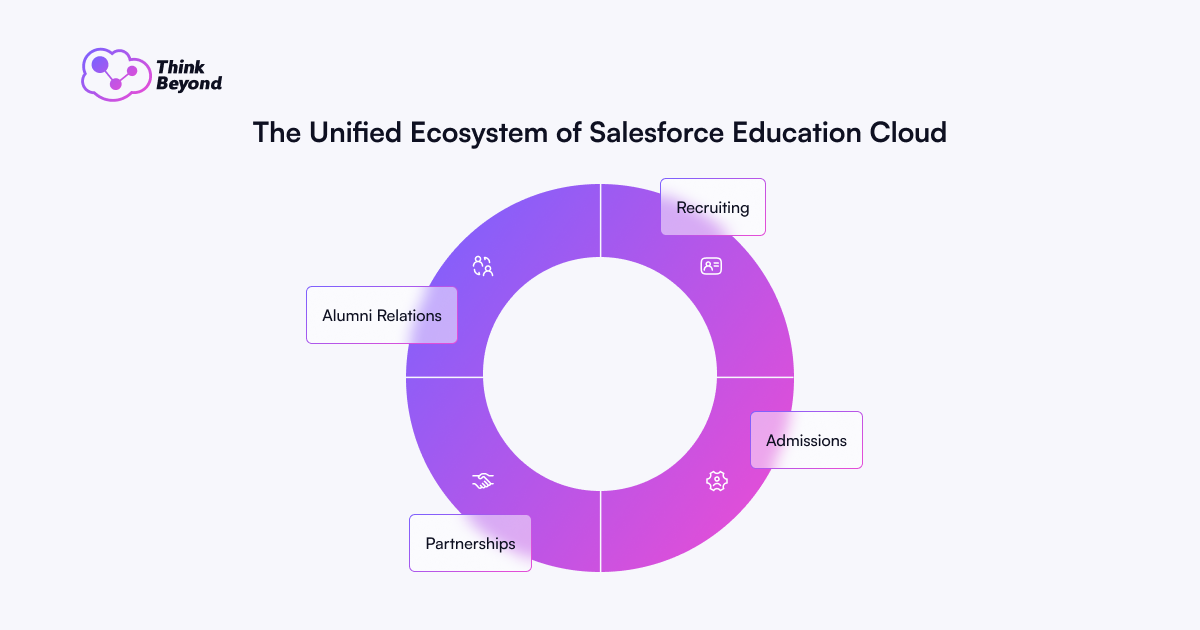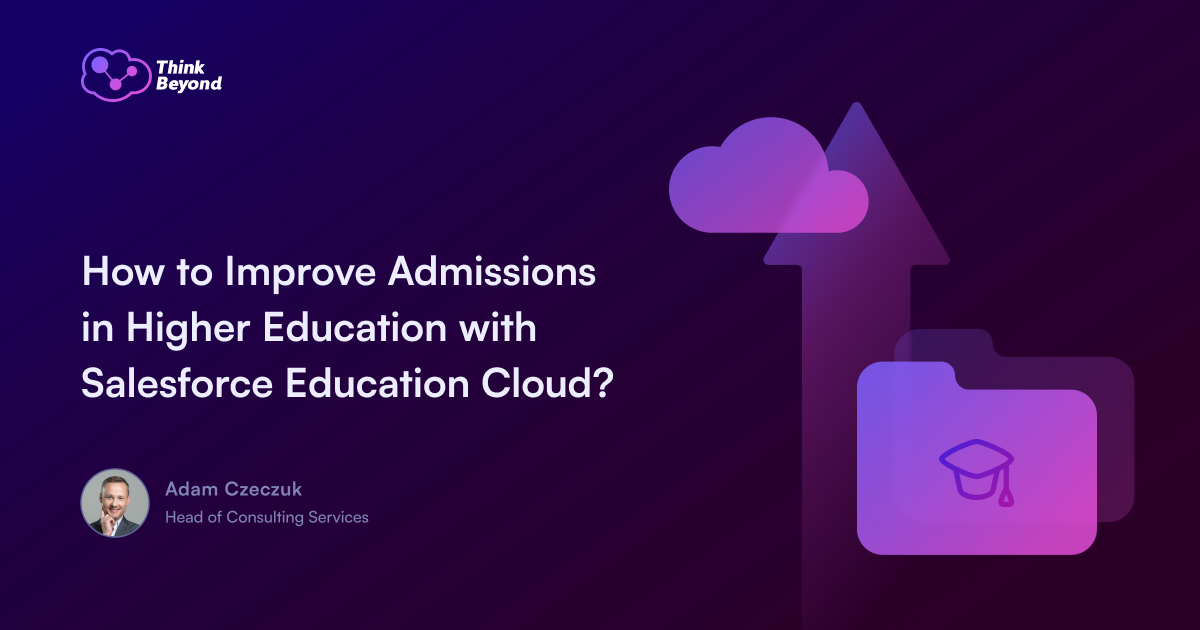Admissions are the lifeblood of higher education institutions. They shape the experiences and outcomes of every student who walks through its digital or non-digital doors. In this process, universities face two major challenges: ensuring operational efficiency and delivering the kind of personalized, engaging applicant experience that modern students expect. What’s the solution that meets both needs?
Salesforce for universities improves every step of the admissions journey, from recruitment and application review to personalized communications and onboarding, while giving applicants the seamless, responsive experience they demand.
In this post, we’ll explore how Salesforce Education Cloud transforms university admissions, making the process smarter, simpler, and more student-centric than ever before.
Why is Implementing Salesforce for Admissions in Higher Education Becoming Important?
University admissions are facing unprecedented challenges and opportunities. The number of applicants continues to rise — according to the Common App, the 2024–2025 cycle saw a 4% increase in students applying and a 6% jump in total applications submitted compared to the previous year. This surge means admissions offices must process and evaluate more applications than ever, often with the same or fewer resources.
At the same time, the adoption of artificial intelligence in college admissions is accelerating. In a recent survey, 50% of admissions professionals reported using AI in their processes, and 82% planned to implement AI tools in 2024. AI is now central to automating repetitive tasks, improving decision-making, and delivering more personalized, timely communication to applicants. These technologies not only boost efficiency but also help institutions provide a fairer and more engaging student experience.
Salesforce stands out as a dedicated platform that brings together admissions management and student engagement on one single CRM platform. Unlike point solutions that address only one part of the process, Salesforce solutions offer a 360-degree view-allowing universities to weave together recruitment, application review, communication, and onboarding seamlessly.
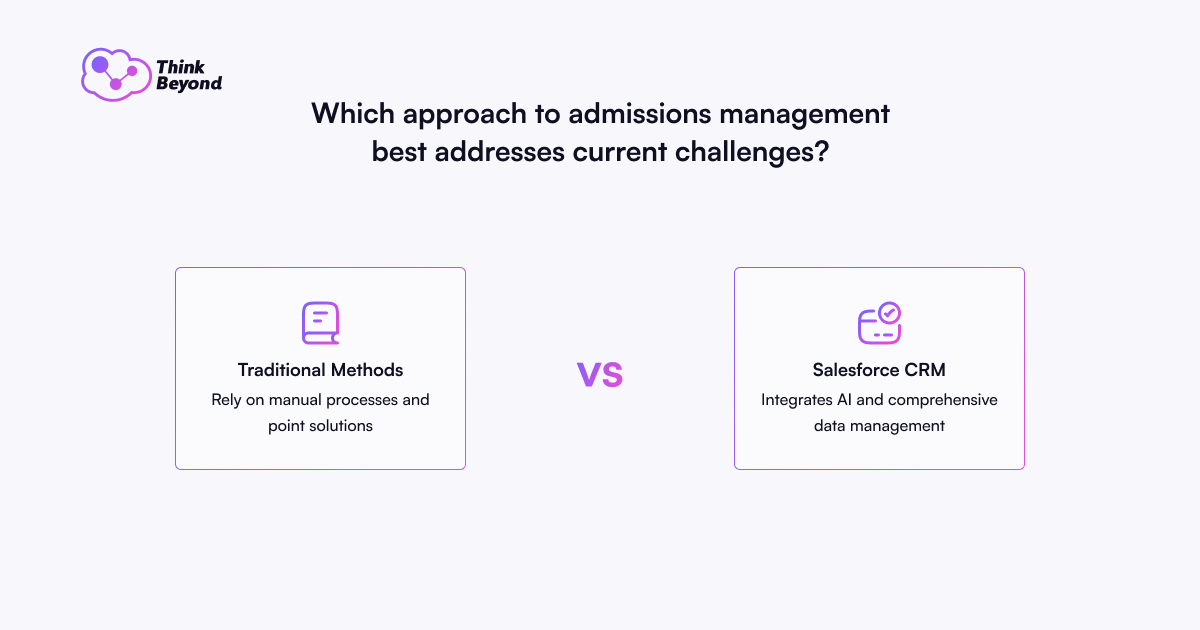
University Admissions Funnel — How Does it Work?
The university admissions funnel is a strategic model that maps the journey of prospective students from initial interest to final enrollment. It is typically divided into three main levels, each with distinct goals and activities:
Top Levels – Building Demand
Prospects: At the very top of the funnel are prospects — students who have not yet engaged directly with the university but are targeted through recruitment campaigns, outreach at fairs, or digital marketing. The aim here is to generate broad awareness and attract as many potential students as possible.
Inquiries: Prospects become inquiries when they show active interest, such as requesting information, signing up for a newsletter, or visiting campus. This is a critical stage where personalized engagement begins, helping prospects determine if the university matches their needs and aspirations.
Middle Levels – Cultivating Applicants
Applicants: Inquiries who decide to take the next step submit their applications. This stage is about guiding and supporting students through the application process, ensuring they have all the information and resources needed to complete their submissions.
Admits: Once applications are reviewed, qualified applicants are offered admission. The focus now shifts to nurturing these admitted students, answering their questions, and helping them see the value of enrolling at the institution.
Bottom Levels – Optimizing Yield
Enrolled: The final stage of the funnel is enrollment. Here, admitted students confirm their intention to attend, often by submitting a deposit and completing all onboarding steps. The university’s goal is to optimize yield, ensuring as many admitted students as possible become enrolled students.
Throughout the admissions funnel, universities use targeted strategies and metrics such as conversion rates between stages and yield rates to identify strengths and gaps in their process.
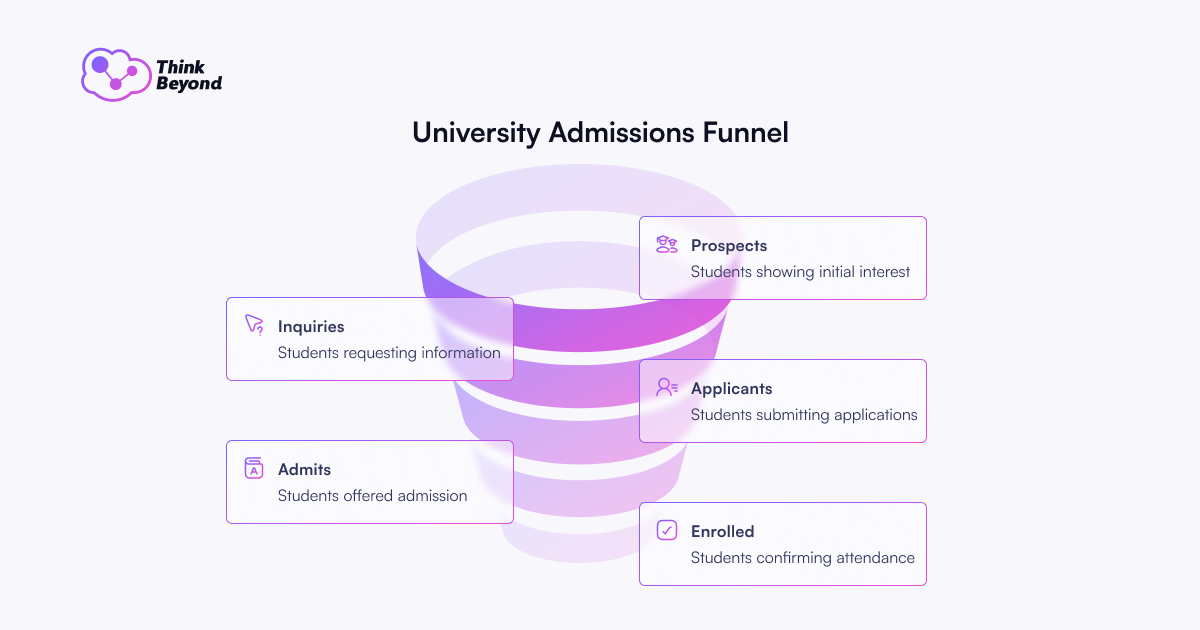
Salesforce Education Cloud Helps from the Inquiry to the Enrollment
Preparing the Admissions Cycle
Before the application period opens, the admission portal built on Experience Cloud online recruitment system is updated with the latest program offerings, entry requirements, and important dates. Coordination with academic departments confirms any changes to admission criteria or procedures, such as new entrance exams or interviews.
- Salesforce enables institutions to centralize all prospective student and application information on a single platform, making it easy to update, manage, and access data as the admissions cycle is set up. Application stages, workflows, and Omnistudio components can be configured to match the institution’s unique admissions process.
- Admissions staff can collaborate in real time, assign and track tasks, and monitor the overall progress of the admissions cycle using dashboards and activity reports. Leadership has access to real-time insights into the status of preparations, can identify bottlenecks, and allocate resources efficiently.
Assisting Applicants
Once applications open, the admissions office serves as the primary point of contact for prospective students. Staff respond to emails, phone calls, and in-person queries regarding the application process, required documents, and program details. Assistance is also provided to applicants experiencing technical difficulties with the online system or seeking clarification about eligibility.
- With Service Cloud, universities offer one-stop, always-available support for applicants. The higher education institutions can provide access to a centralized portal where the applicants track their application status, submit inquiries, and receive instant responses. This reduces confusion and ensures no question goes unanswered, regardless of time zone or schedule.
- Salesforce’s Agentforce allows for the deployment of AI agents that provide round-the-clock support. These agents answer applicant questions, guide them through requirements, and offer tailored recommendations based on individual profiles and interests. AI agents can also follow up with applicants to ensure all documents are submitted on time, reducing administrative bottlenecks and improving completion rates.
Application Review
The admissions system makes sure applications are uploaded and fees are paid. For incomplete applications, applicants receive notification of missing items and receive guidance on how to resolve issues.
- The review interface enables applicants to be rated on specific criteria, with detailed comments and admissions recommendations captured within a standardized and customizable framework that aligns with institutional requirements. For programs with unique needs, the review process can be tailored so that different criteria, forms, or workflows are used for various departments or applicant types.
- Salesforce CRM guarantees that current information is consistently accessible, facilitating faster, more precise, and more consistent decision-making throughout the admissions process, regardless of whether a staff member is reviewing applications or an AI agent is carrying out routine checks.
- All application materials including transcripts, essays, and recommendation letters are accessible in one place. Reviewers can view documents, streamlining the evaluation of supporting materials. The system supports secure storage and easy retrieval of all applicant data, maintaining compliance and data integrity.
Qualification and Selection
Once the application deadline passes, the formal evaluation process begins. This process includes:
- Verifying the authenticity and completeness of submitted documents.
- Calculating scores or ranking applicants based on grades, exam results, or other criteria.
- Coordinating with faculty members for additional assessments if required.
- Compiling the results and generating preliminary lists of qualified candidates
What does Salesforce offer?
- Admissions staff can organize, visualize, and automate the review process by stage, making it easy to see where each applicant is in the pipeline and to identify any bottlenecks or delays. Helpful icons and status updates provide instant visibility into each applicant’s progress.
- Scoring and evaluation tools within Salesforce allow for standardized, transparent, and equitable decision-making. Reviewer recommendations and scores are captured directly in the system, supporting consistency and reducing bias in the selection process.
Announcing Results
Results are posted on the online system, and applicants are notified via email or other channel preferred by the applicant. Accepted applicants receive clear instructions on the next steps, including deadlines for submitting original documents and confirming their place.
- Salesforce enables admissions staff to update the Application Status and Application Decision Date fields directly on each applicant’s record. This ensures all decisions-admitted, waitlisted, or denied-are accurately recorded and instantly reflected in the system.
- Once decisions are finalized, Salesforce triggers automated notifications to applicants. These notifications can be customized based on the applicant’s outcome and delivered via preferred channels such as email, SMS, or an online portal, ensuring timely and consistent communication. Applicants can log into their personalized online portal to view results, download official decision letters, and access next steps.
Enrollment and Finalization
Accepted students are required to submit original documents, such as diplomas, transcripts, and identification. These documents are carefully checked for authenticity and completeness. Once all requirements are met, enrollment in the university system is confirmed. For international students, additional support is provided regarding visas, translations, and legalizations.
- Automated, personalized onboarding journeys can be set up using Salesforce Marketing Cloud. Each admitted student receives tailored checklists, reminders, and next-step instructions based on their program, background, or specific needs. Onboarding care plans can be created and tracked for every student, ensuring completion of all required steps, such as submitting final documents, paying deposits, or registering for orientation, while providing ongoing support throughout the process.
- Salesforce integrates with existing student information systems (SIS), financial aid, and course management platforms, ensuring data consistency and smooth handoffs between departments. All student data and actions are securely stored and auditable, supporting compliance with institutional policies and data protection regulations.
Ongoing Support
Throughout the process, support is available to answer questions, resolve issues, and provide guidance. The aim is to make the admissions experience as transparent and stress-free as possible for every applicant.
All application decisions, supporting documentation, and reviewer notes are securely stored and easily auditable, helping ensure compliance with institutional policies and data protection regulations.
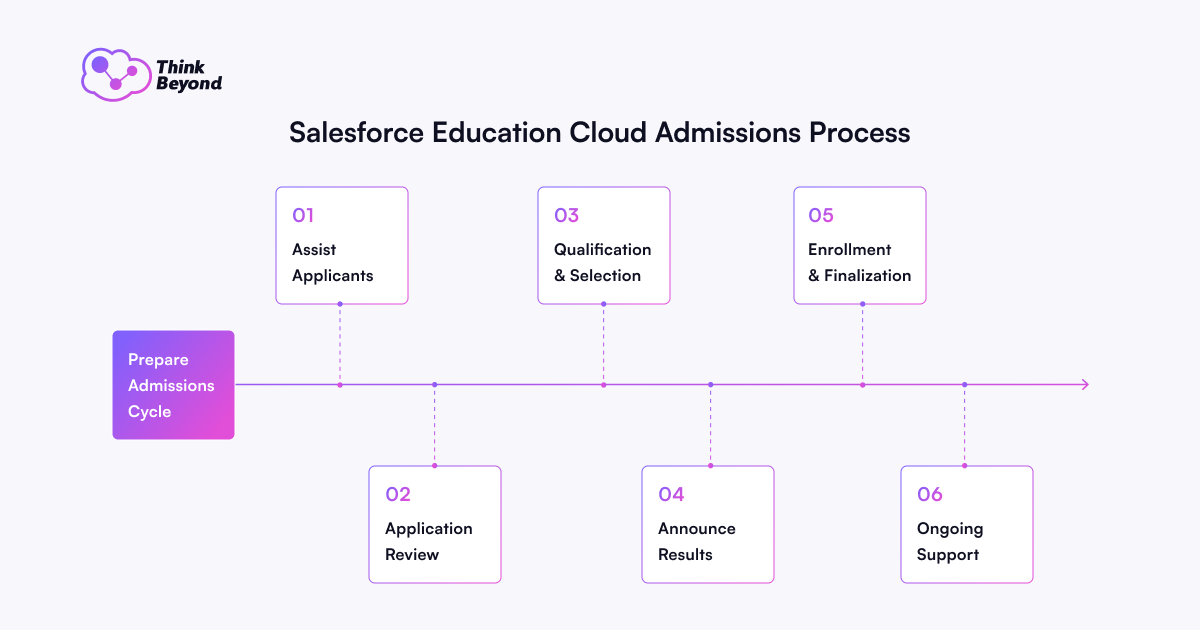
The Advantage of Salesforce CRM for Shaping Student Engagement
Salesforce implementation is a game-changer for universities, not just for admissions but as a comprehensive platform that connects every aspect of campus life. While many institutions use specialized tools for recruiting, admissions, partnerships, or alumni relations, Salesforce Education Cloud stands out by offering a single, unified ecosystem that integrates all these functions.
As one CIO of a public research university put it:
There are great recruiting and admissions tools. There are adequate tools to manage partnerships and sponsorships. There are even some good solutions for dealing with alumni relations. But we felt that Salesforce was the only vendor that provided a single platform across all of those areas. Salesforce allowed us to weave the 360-degree view of our constituents across the various systems that we work with. (Forrester Report, The Total Economic Impact™ of Salesforce.org Education Cloud)
Salesforce for higher education is beneficial for colleges and universities because it is not just an admissions tool. It is the backbone of a modern, connected campus, empowering institutions to deliver better outcomes for every member of their community.
